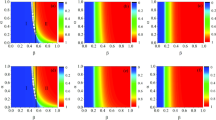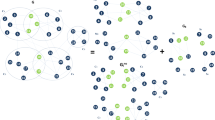Abstract
Information spreading on social networks is one of the most important topics in network science and has long been actively studied. However, most studies only focus on the spread of a single piece of information on random networks, even though information spreading in the real world is much more complicated, involving a complex topology structure and interactions between multiple information. Therefore, in this paper, we model the competitive information spreading on modular networks and investigate how the community structure affects competitive information spreading in two spreading scenarios: sequential and simultaneous. In the sequential spreading scenario, we find that the community structure has little effect on the final prevalence but affects the spreading process (time evolution of the prevalence). In contrast, in the simultaneous spreading scenario, we find that community structure has a strong effect on not only the spreading process but also the final prevalence. Specifically, two competing pieces of information cannot coexist and one drives out the other on a non-modular network, whereas they can coexist in different communities on a modular network. Our results suggest that the effect of community structure cannot be ignored in the analysis of competitive spreading (especially, simultaneous spreading) of multiple information.
Access this chapter
Tax calculation will be finalised at checkout
Purchases are for personal use only
Similar content being viewed by others
References
Goffman, W., Newill, V.: Generalization of epidemic theory. Nature 204(4955), 225–228 (1964)
Bettencourt, L.M., Cintrón-Arias, A., Kaiser, D.I., Castillo-Chávez, C.: The power of a good idea: quantitative modeling of the spread of ideas from epidemiological models. Phys. A Stat. Mech. Appl. 364, 513–536 (2006)
Anderson, R.M., May, R.M.: Infectious diseases of humans: dynamics and control. Oxford University Press, Oxford (1992)
Keeling, M.J., Rohani, P.: Modeling Infectious Diseases in Humans and Animals. Princeton University Press, Princeton (2011)
Watts, D.J.: A simple model of global cascades on random networks. In: The Structure and Dynamics of Networks, pp. 497–502. Princeton University Press (2011)
Granovetter, M.: Threshold models of collective behavior. Am. J. Sociol. 83(6), 1420–1443 (1978)
Wang, W., Tang, M., Zhang, H.-F., Lai, Y.-C.: Dynamics of social contagions with memory of nonredundant information. Phys. Rev. E 92(1), 012820 (2015)
Centola, D.: The spread of behavior in an online social network experiment. Science 329(5996), 1194–1197 (2010)
Mønsted, B., Sapieżyński, P., Ferrara, E., Lehmann, S.: Evidence of complex contagion of information in social media: an experiment using twitter bots. PLoS ONE 12(9), e0184148 (2017)
State, B., Adamic, L.: The diffusion of support in an online social movement: evidence from the adoption of equal-sign profile pictures. In: Proceedings of the 18th ACM Conference on Computer Supported Cooperative Work & Social Computing, pp. 1741–1750 (2015)
Karampourniotis, P.D., Sreenivasan, S., Szymanski, B.K., Korniss, G.: The impact of heterogeneous thresholds on social contagion with multiple initiators. PLoS ONE 10(11), e0143020 (2015)
Min, B., San Miguel, M.: Competing contagion processes: complex contagion triggered by simple contagion. Sci. Rep. 8(1), 1–8 (2018)
Newman, M.E., Strogatz, S.H., Watts, D.J.: Random graphs with arbitrary degree distributions and their applications. Phys. Rev. E 64(2), 026118 (2001)
Galstyan, A., Cohen, P.: Cascading dynamics in modular networks. Phys. Rev. E 75(3), 036109 (2007)
Gleeson, J.P.: Cascades on correlated and modular random networks. Phys. Rev. E 77(4), 046117 (2008)
Nematzadeh, A., Ferrara, E., Flammini, A., Ahn, Y.-Y.: Optimal network modularity for information diffusion. Phys. Rev. Lett. 113(8), 088701 (2014)
Liu, Q.H., Zhong, L.F., Wang, W., Zhou, T., Eugene Stanley, H.: Interactive social contagions and co-infections on complex networks. Chaos Interdisc. J. Nonlinear Sci. 28(1), 013120 (2018)
Min, B., San Miguel, M.: Competition and dual users in complex contagion processes. Sci. Rep. 8(1), 1–8 (2018)
Gleeson, J.P., Cahalane, D.J.: Seed size strongly affects cascades on random networks. Phys. Rev. E 75(5), 056103 (2007)
Gleeson, J.P., Porter, M.A.: Message-passing methods for complex contagions. In: Lehmann, S., Ahn, Y.-Y. (eds.) Complex Spreading Phenomena in Social Systems. CSS, pp. 81–95. Springer, Cham (2018). https://doi.org/10.1007/978-3-319-77332-2_5
Hardin, G.: The competitive exclusion principle. Science 131(3409), 1292–1297 (1960)
Amarasekare, P.: Competitive coexistence in spatially structured environments: a synthesis. Ecol. Lett. 6(12), 1109–1122 (2003)
Author information
Authors and Affiliations
Corresponding author
Editor information
Editors and Affiliations
Rights and permissions
Copyright information
© 2022 Springer Nature Switzerland AG
About this paper
Cite this paper
Furutani, S., Shibahara, T., Akiyama, M., Aida, M. (2022). Competitive Information Spreading on Modular Networks. In: Ribeiro, P., Silva, F., Mendes, J.F., Laureano, R. (eds) Network Science. NetSci-X 2022. Lecture Notes in Computer Science(), vol 13197. Springer, Cham. https://doi.org/10.1007/978-3-030-97240-0_12
Download citation
DOI: https://doi.org/10.1007/978-3-030-97240-0_12
Published:
Publisher Name: Springer, Cham
Print ISBN: 978-3-030-97239-4
Online ISBN: 978-3-030-97240-0
eBook Packages: Computer ScienceComputer Science (R0)




